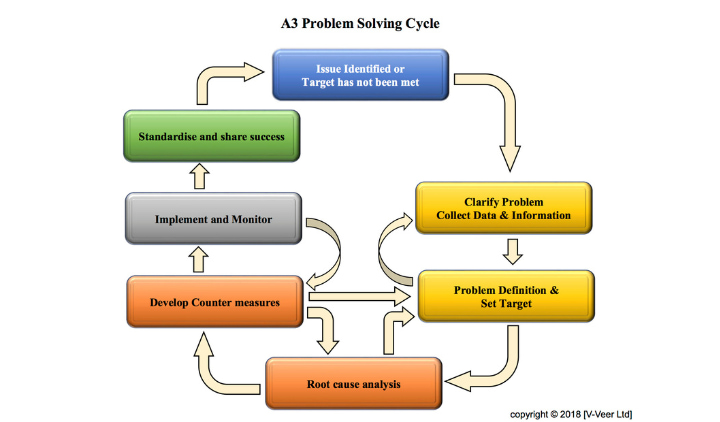The A3 problem solving is one of the most used lean tools out there today. But, unfortunately it is also one of the most misused, too.
The aim of the A3 at Toyota, based on literature and the many advocates of TPS, is to have a strong structured way to reach the root cause and achieve sustainable countermeasures. Also, it targets to summarise the full cycle: from identifying the problem to celebrating success on one single sheet. Most lean practitioners will already know this.
When I first came across the A3 one of the learnings was that the A3 has to be messy and rewritten several times on the same sheet. The fundamental premise being that the more it is erased and rewritten the better A3 it was. That kept me thinking. For years I did not fully understand the reason or method that dictates I rewrite it again and again.
When examining A3’s today you will find that they are weak or missing critical information that enables reaching the true root-cause. Some may (mis)understand it to be a format for documenting a problem once the solution was done, rather than a ‘live’ document that supports the process of solving.
I would like to take you on the journey of an A3 problem solving cycle by explaining the picture attached. To do this, I would like you to start by thinking of the board game “Snakes & Ladders”. Though you are clear on the goal (making it to the end of the board), you are not always sure when you will slide and have to retake a few steps again. You may be close to the end, but you slid to the start and have to start all over again. Those of us who played this game already know there is no end to the number of times you may be set back, but you keep persisting till you reach the end. When problem solving, your aim is to close a gap from the standard or achieve a target. The thing you don’t always know is how long the pathway to reach it is, or how many times you might repeat a few steps. This is no different from the board game (but without the dice).
The starting point in the problem solving cycle is identifying a problem or missed target. This is followed by the first 2 steps of Toyota Method: clarifying the problem and breaking it down (by collecting data and information). This is then followed by defining the problem and setting the target. At this point you face the first returning loop (i.e. a link between two steps to ensure the subsequent stage meets the needs of the one prior to it. It also shows what to do if a stage fails and does not achieve its results).
Before proceeding to Root Cause Analysis, it is critical the correct problem definition & targets have been identified. Accuracy of the definitions has to be validated using the data and information gathered.
Once at Root Cause Analysis, we encounter the second returning loop. This loop is often considered the most critical and longest of all; as the problem solver must ensure s/he has identified the right cause(s) for the problem defined.
After identifying the root cause(s), appropriate countermeasures can be sought. This is when the returning loops can ‘get messy’; as the problem solver may go back to the definition of the problem or the root cause analysis. The first of these loops goes back to the root cause to validate whether the countermeasure eliminates the cause. The other loop is designed to ensure countermeasures meeting the standards set out – simply put, they ask: “will it achieve the target that has been set? And, is the problem going to go away?”
If the study demonstrates the countermeasure meets all requirements, we can proceed to implementation and start monitoring results. If the results do not achieve the targets or does not solve the problem, we go back to finding or exploring other countermeasures.
If you assume that at the last loop you keep going till you get it right (correct countermeasure), you still miss the point. The whole loop network is connected. Going back on one loop may take you back into earlier loops. For example, you may reach Implementation; but countermeasures do not work, and the problem still persists. This means you must return to the Develop Countermeasures stage; but at this point you may want to go back to the Problem Definition and examine it again: Do you really have the right problem definition? In turn, this may take you back to reviewing the data and information you have, and examine it all over again.
By looking at this whole process, I got to answer and understand the question that I had years ago about the reason and method that requires me to rewrite an A3 again and again.
Thats the power of the A3 tool, it helps ensure we achieve the correct countermeasures to eliminate the problems, forever. For this to be achieved any problem solver needs to have patience, determination and a strong will not to give up.
Remember that the A3 problem solving is a journey, and you have to take your time through it.


It works quite well for me
Thanks to the terrific manual
Make a more new posts please 🙂
___
Sanny
Nice posts! 🙂
___
Sanny
“Thanks so much for the article.Thanks Again. Really Great.”